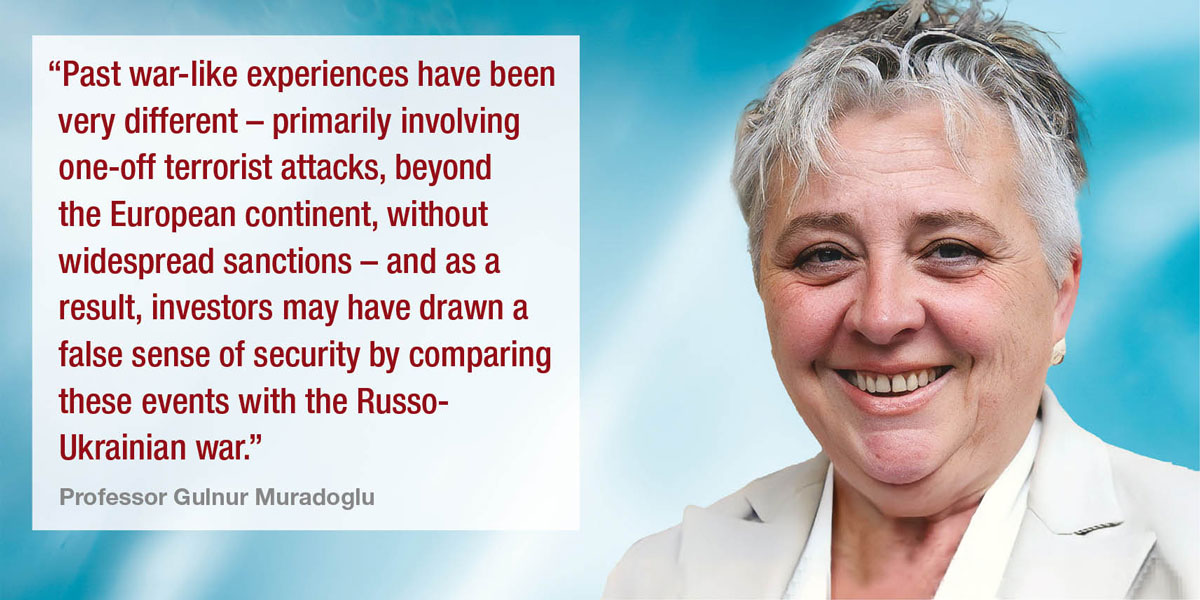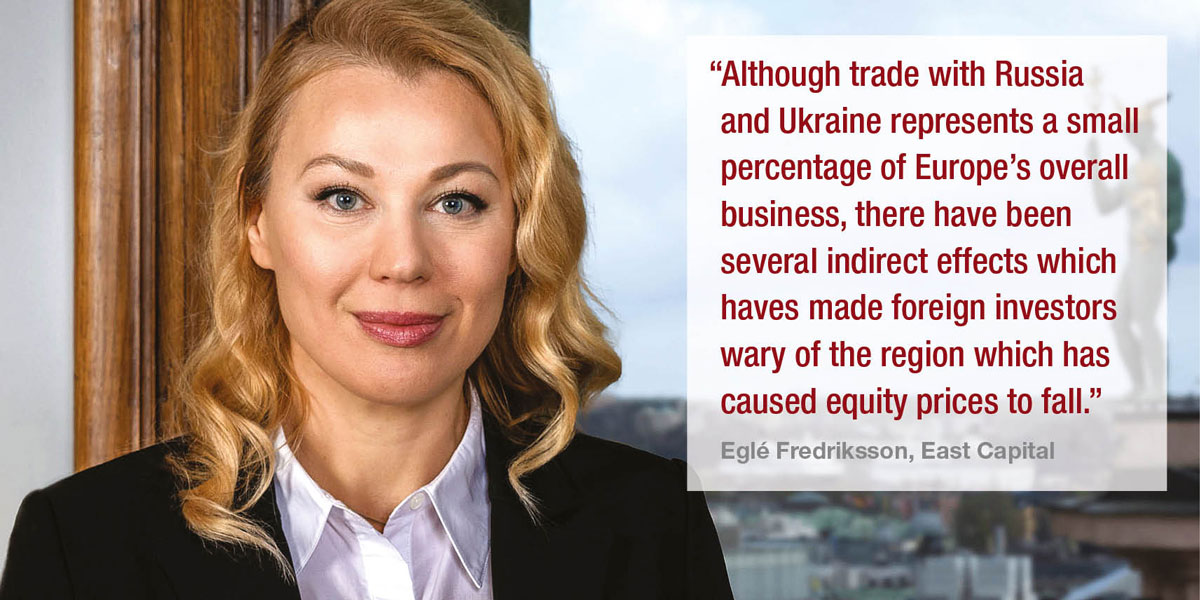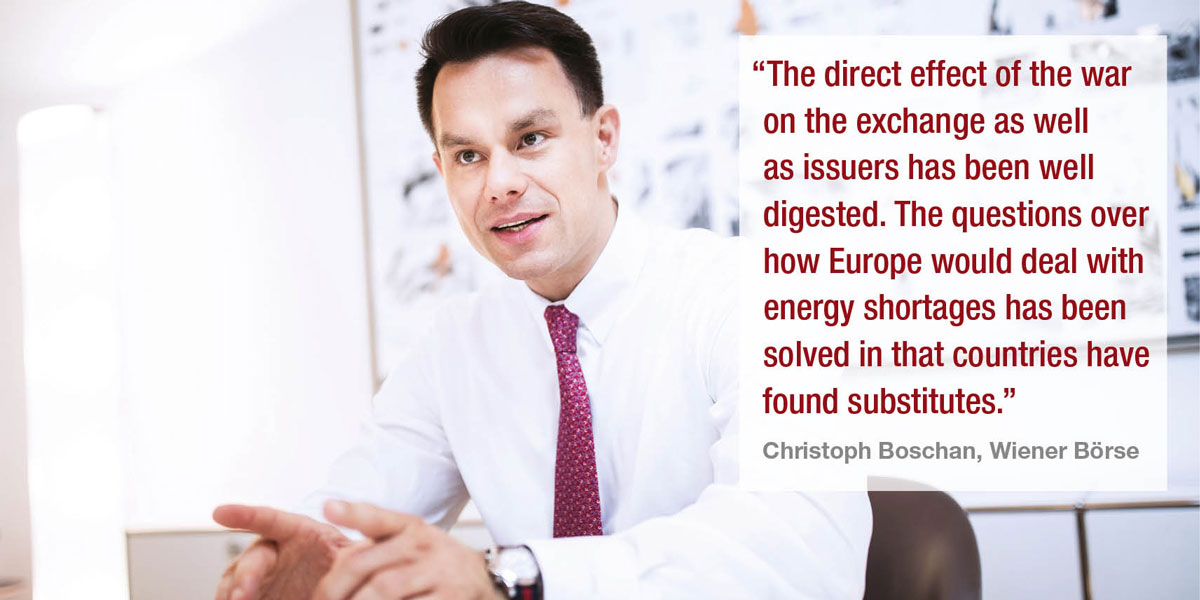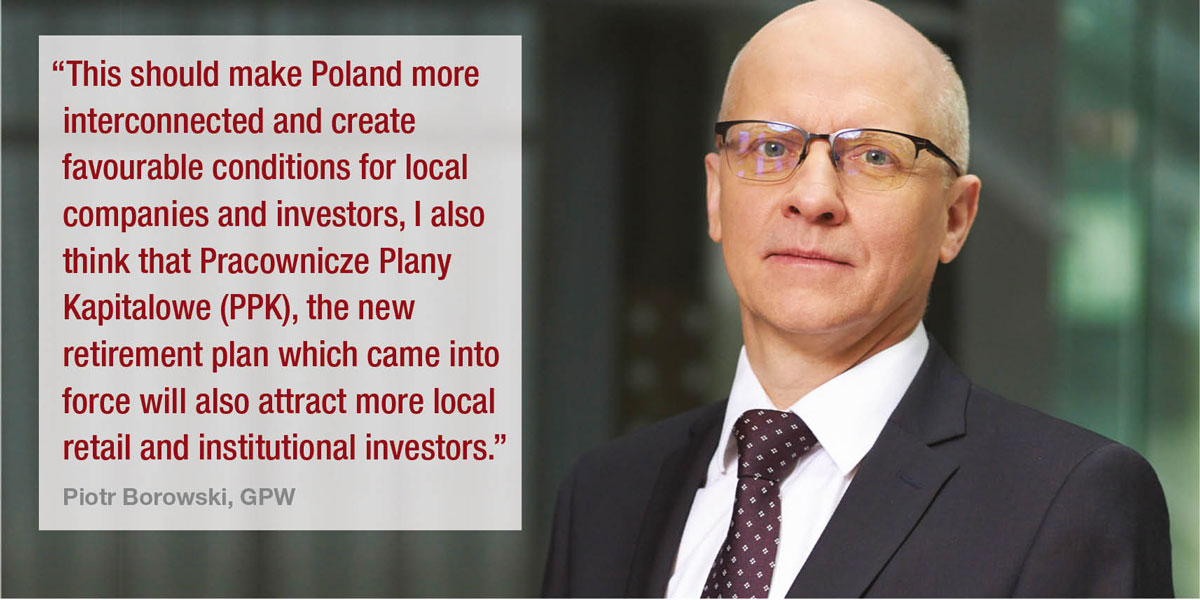why did markets react differently to the Russia-Ukraine war than other recent crises?
Although stock exchanges in Central and Eastern Europe (CEE) were the most impacted by the war in Ukraine, their reaction to events was similar to their counterparts in North America and Western Europe. Prices tumbled but the damage could have been much worse as traders navigated the turmoil.
This is reflected in research from MSCI which said, “contrary to what many would have expected, given their proximity to the war, European equity markets did not do as badly as feared and – in fact, if measured in local currency over the one-year period – ended up 2% in 2022.”
Not surprisingly, countries that were closest to the conflict zone, and gas dependent on Russia -notably, Hungary, Poland and Germany – exhibited high negative returns – but the UK’s FTSE 100 was up 0.9% in 2022. This though can be attributed to the composition of the index where 82% of its revenues emanate from overseas markets. This figure drops to 57% for the more UK-centric FTSE 250, which plunged 19.7% in 2022.
These trends are also reflected in research from Professor Gulnur Muradoglu, professor of finance at Queen Mary University of London and co-author of paper – The reaction of G20+ stock markets to the Russia–Ukraine conflict “black-swan” event. Analysing country wide abnormal returns, it showed that the stockmarkets of Hungary, and Poland, along with Russia and Slovakia reacted negatively in both the pre- and post- event days, whereas Australia, France, Germany, India, Italy, Japan, Romania, South Africa, Spain, and Turkey were adversely affected in just the post-event days.
Although sabre-rattling is not new in Russia, few predicted a full scale invasion of Ukraine. Many anticipated an annexation of a region within Ukraine akin to the events in Crimea nine years ago. The move was publicly condemned but it did not significantly move markets or dent the global economy. This explains why markets reacted in a much sharper and quicker way than in the pandemic or global financial crisis of 2008, when there was a lag of up to a week before investors acted, according to Muradoglu.
She attributes this to investors and traders immediately viewing the invasion as “real or serious news” on the global financial stage. However, she notes that although more immediate, the intensity of the market response was noticeably smaller than Covid-19 or the global financial crisis, because the general consensus was that the war would be short-lived.
She notes that past war-like experiences have been very different – primarily involving one-off terrorist attacks, beyond the European continent, without widespread sanctions – and as a result, investors may have drawn a false sense of security by comparing these events with the Russo-Ukrainian war.
In fact, studies have shown that over the last two centuries, most wars have lasted an average of three to four months. That brevity owes much to the fact that war is the worst way to settle political differences. As the costs of fighting become apparent, adversaries usually look for a settlement.
Back to basics
One year on, and there is an acceptance that the war will continue for the foreseeable future and traders’ attention has shifted to the fallout, most notably higher inflation and interest rates. The war not only threatened the stability of Europe but it has also impacted food and energy security globally including in the Middle East and Africa, which reverberated across a world that was just emerging from the pandemic.
“The focus is back on the fundamentals,” says Eglé Fredriksson, portfolio manager at East Capital. “Although trade with Russia and Ukraine represents a small percentage of Europe’s overall business, there have been several indirect effects which have made foreign investors wary of the region, which has caused equity prices to fall”.
However, Fredriksson believes investor sentiment is turning more positive because the worst case scenario did not materialise. Energy prices did not skyrocket as high as expected and the threat of a recession has abated. Moreover, the region’s economy, especially in Poland, has been given a boost due to the influx of Ukrainian refugees, many of whom have joined the workforce.
Christoph Boschan, CEO of Wiener Börse, which is also owner of the Prague Stock Exchange, echoes these sentiments. “The direct effect of the war on the exchange as well as issuers has been well digested,” he says. “The questions over how Europe would deal with energy shortages has been solved in that countries have found substitutes. It is also important not to overestimate the impact of the war as Ukraine together with Russia only represents a small percentage of Austria and Germany’s trade.”
Boschan also credits the exchange’s recent initiatives implemented over the past two years as strengthening its position as a proxy to invest in CEE markets. This includes diversifying away from leveraged markets to real economy companies that have a strong track record of paying dividends. In addition, it recently launched a new market data distribution infrastructure whereby over 270 customers receive stock market data from 11 markets, four times faster than in the past.
The Warsaw Stock Exchange, (GPW) is also hoping to boost liquidity with its new GlobalConnect, that allows investors to invest in shares of global companies in the Polish currency (Zloty) during trading sessions in Warsaw. “This should make Poland more interconnected and create favourable conditions for local companies and investors,” says Piotr Borowski, capital markets adviser and former chief operating officer, management board at GPW. “I also think that Pracownicze Plany Kapitalowe (PPK), the new retirement plan which came into force will also attract more local retail and institutional investors”
Effective this year, all companies are required to automatically enrol new hires age 18 to 54 in the PPK retirement plan within three months of starting work, unless the employee submits a declaration to opt out of participation.
Tried and tested
Although stock exchanges in the region are introducing new measures to generate liquidity, traders are and have turned to tried and tested tools and strategies such as sophisticated algos, transaction cost analysis and charting to glean valuable insights.
As for strategies, some follow stocks that move with the market as volatility doesn’t always erase these trends. For example, certain equities may continue to move in a particular direction – albeit with a potentially higher degree of risk. The goal is to trade before the stock price spikes which is why the focus should be on equities that have been moving higher at a steady pace but haven’t yet skyrocketed.
The breakout trade is also fashionable. This involves traders buying immediately when the price breaks through the resistance level, in the hope that the breakout signals mark the beginning of a new sustained move upwards.
However, although traders need to be au fait with the latest tech and have access to quality, actionable data, they also need to keep calm and be patient. Sitting on the sidelines is also not a bad strategy. As market participants have often noted, sometimes, the best trade to make is not to trade at all.





